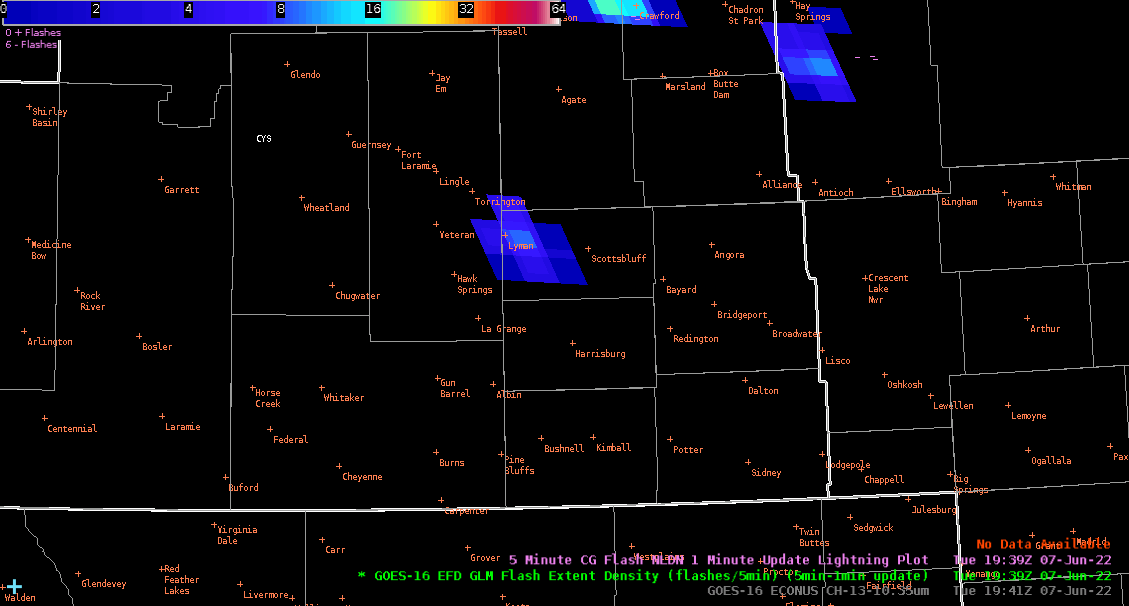Differences between the GLM Flash Extent Density products from GOES-16 and GOES-17 were quite stark for convection occurring over the Cheyenne, WY CWA on June 7th.
The two animated gifs below highlight the difference in lead times for an observed uptick in lightning activity within a cell near Scottsbluff, NE. The first animation is of GOES-17 showing the uptick in lightning activity beginning at 1939Z. The second animation from GOES-16 shows the same uptick in lightning activity, except beginning ~5mins later at 1945Z. Interestingly enough, both satellite perspectives show the downtrend in lightning activity occurring at 1950Z.

GOES-17 GLM FED Scottsbluff 5-min improved lead time.

GOES-16 GLM FED Scottsbluff
The next three examples show sharp contrasting GLM FED intensities between GOES-17 and GOES-16 through the afternoon of June 7th. This first example focuses on a warned supercell just southeast of Scottsbluff, NE at 2022Z. The first image shows FED from GOES-17 showing much higher FED numbers, while the second image shows FED from GOES-16 not indicating any increased lightning activity. The third image shows a 4-panel layout of MRMS, MESH, VIL, and ProbSevere version 3 all supporting a supercell occurring. A subsequent report of 1.5” hail was observed from this warned storm.
The cause of this was shared from the investigators running the HWT this week, that GOES-17 had the better angle to see lightning activity in these supercells developing over the high plains of WY and NE. Whereas GOES-16’s perspective from further east had to punch through spreading anvils downstream of the main updraft that likely obscured the light emanating from the lightning, GOES-17 had a more side-on view of the updraft with less to no obscurations of light emanating from lightning occurring in the updraft. Unfortunately, GOES-17 CONUS view and the day’s mesosector from GOES-17 did not reach this far east and there are no satellite images displaying the different parallax views from GOES-16 and GOES-17.

GOES 17 GLM FED @ 2022Z “Scottsbluff Cell”

GOES 16 GLM FED @ 2022Z

MRMS – MESH – VIL – PROBSEVEREv3 @ 2022Z
1.5” hail report from this storm. Max MESH reached 2”.
The next two examples below each showcase three images each, a GOES-17 FED showing higher intensity lightning activity, a GOES-16 FED missing the higher intensity lightning activity, and a 4-panel layout showing MRMS, MESH, VIL, and ProbSevere version 3 highlighting the severe nature of the supercell.
An interesting follow-up to this in the future is to see how these two satellite GLM FED products compare in a low-storm motion environment where the spreading anvils at storm top flow in all directions. This could cause both satellites to have an obscured view of the convective updraft beneath, causing both to miss out on any increased lightning activity.

GOES-17 GLM FED @ 2016Z “Lance Creek Cell”

GOES-16 GLM FED @ 2016Z “Lance Creek Cell”

MRMS – MESH – VIL – PROBSEVEREv3 @ 2016Z

GOES-17 GLM FED @ 2026Z “Scottsbluff Cell”

GOES-16 GLM FED @ 2026Z “Scottsbluff Cell”

MRMS – MESH – VIL – PROBSEVEREv3 @ 2026Z “Scottsbluff Cell”
– Trip

